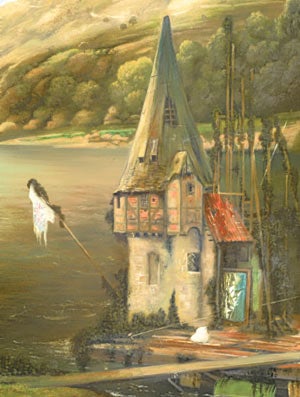Ged Quinn, Stephen Friedman Gallery, London

A tremendous windbag is holding forth to a docile tour group in one of the two gallery spaces, so I scuttle away at breakneck speed. A little later, having considered these five large (and two small) canvases by Ged Quinn, I can see that the kind of work that he makes could easily be very sympathetic to the kind of higher windbaggery that is going on next door.
Quinn makes wierdly anachronistic landscape paintings that are grandiose in manner (or perhaps mock-grandiose) and on a giant scale. They contain wilful elements of fantasy – a ruined tower encloses a guillotine; a little way away, a two-headed goat minds its own business. At first glance, they often look like paintings by Claude. There is that same sweeping sense of space, those same sweetly docile colours. Mountains fade back into a kind of golden haze as they withdraw from us. Great plains unroll, illimitably. Forests loom.
A closer glance reveals this to be true only partially. Quinn makes paintings rather in the way that some of the great Modernist poets of the 20th century used to make their poems. He assembles them from a ragbag of visual references to the past, snatching at bits and pieces from different centuries. Like Ezra Pound's Cantos, they are giant collages of mannerisms and motifs. Here we see a snatch of Ruisdael, there – surely! – is a passage painted in the manner of Rembrandt. The conjunctions can be utterly bizarre. This habit of yoking together unlike things with violence puts us in mind of that 19th-century proto-Surrealist, Lautréamont, who once described a young boy as being "as beautiful as the chance meeting on a dissecting-table of a sewing-machine and an umbrella."
There are no sewing machines in a painting called Flaschenpost, but there are other equally strange elements posed in conjunction with each other. It is a pastoral scene, with woods, a lake, retiring hills. A raft is moored to the lake's edge. Its name – written on the belling canvas sail – is Solaris. A tattered Union Jack is tethered to a flag pole. On the bank, two children are seated on the end of what looks like a cross between a piece of Modernist sculpture and an architectural maquette for a housing development. They are cradling a lamb. One of them wears the cap of a Russian soldier; the other is kitted out as a member of the Hitler Youth. A spade with a Renaissance sword hilt lies on the ground.
Everywhere, in almost all these paintings, there are teasing, puzzling symbols, often tiny, set amid the woods or in the sky. In another, a monkey is painting a portrait of Nietzsche in a landscape of roaring waters and sublimely soaring hills reminiscent of the Hudson River School painters. Standing across from that monkey is the figure of John Ruskin, that great, 19th-century champion of Gothic. He has the nose of Pinocchio.
We wonder about what all this means. It is evidently a critique of Romanticism – with elements of sci-fi thrown in for good measure. It is a way of re-imagining history painting, of re-inventing it for an age without heroes. Or perhaps it is nothing but a kind of painterly fantasia, bravura painting on a sublime scale for its own sake. Whatever it is, we are inclined to keep on looking.
To 1 June (020 7494 1434)
Join our commenting forum
Join thought-provoking conversations, follow other Independent readers and see their replies
Comments